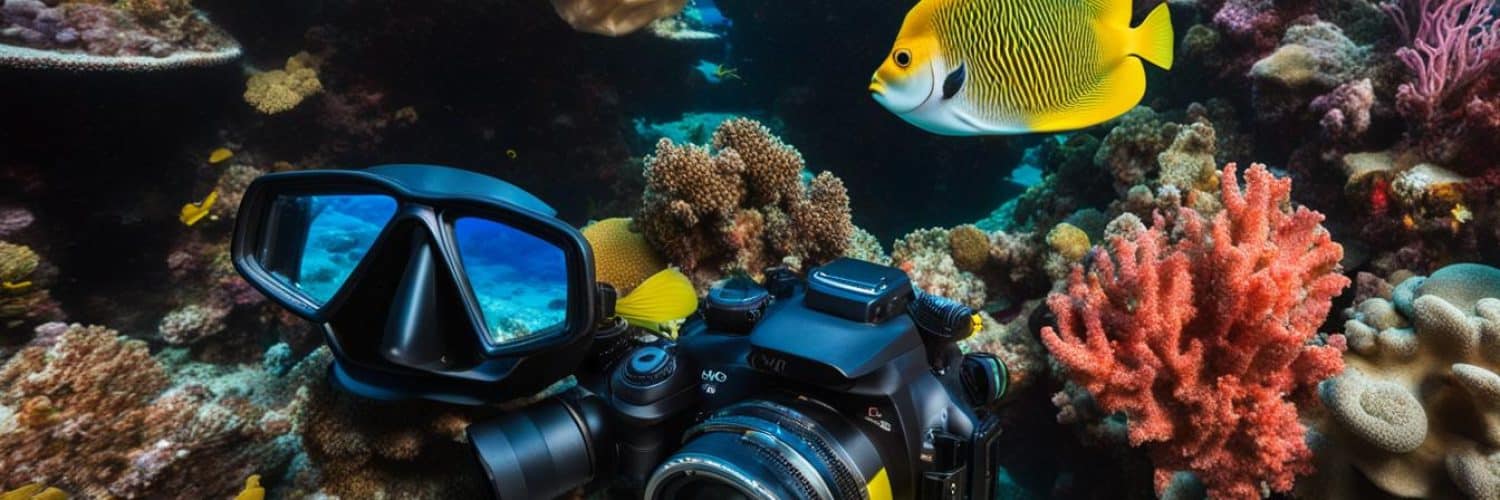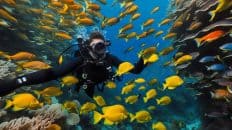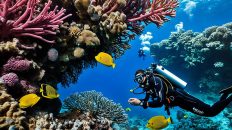Are you passionate about capturing the breathtaking beauty of the underwater world? If so, then having the right dive camera is essential for achieving stunning underwater photography. Whether you are an avid scuba diver or simply enjoy snorkeling, having a reliable waterproof camera can elevate your photography skills to new depths.
When it comes to choosing the best dive camera, there are several factors to consider. Price range, the need for a dedicated underwater camera, zoom capabilities, macro mode, and sensor quality all play a crucial role in finding the perfect camera for your underwater adventures.
Key Takeaways:
- Investing in a quality dive camera is essential for capturing stunning underwater photos.
- Consider factors such as price range, zoom capabilities, and sensor quality when choosing the best dive camera.
- Ensure your chosen dive camera meets your specific needs, especially in terms of underwater capabilities.
- Good lighting is essential for professional underwater photography, so consider investing in additional lighting equipment.
- Recommended dive camera options include the Canon G7X III and the GoPro Hero10.
Determining Your Price Range and Usage
Before purchasing an underwater camera, it is crucial to determine your price range and consider how you will be using the camera. Are you planning to use it solely for scuba diving, or will you also be capturing moments above water? By understanding your budget and usage requirements, you can make a more informed decision and avoid overspending on unnecessary features or accessories.
An underwater camera can range in price from affordable options for beginners to high-end models with advanced capabilities. Assessing your price range early on will help narrow down your options and ensure that you find a camera that meets your needs without breaking the bank.
When considering usage, think about the specific environments and activities you will be capturing with your underwater camera. If you plan to use it primarily for scuba diving, you may need a camera with specific features such as a reliable housing that can withstand the depths and pressures of the ocean. On the other hand, if you anticipate using the camera for a variety of water-related activities, you may want a more versatile option that performs well both underwater and above the surface.
Remember, choosing an underwater camera is a personal decision, and what works for one person may not be the best fit for another. By understanding your price range and usage requirements, you can find the perfect camera that matches your needs and allows you to capture stunning underwater moments.
Quote:
“Determining your price range and understanding your usage needs are essential steps in finding the right underwater camera. By setting a budget and considering how you will be using the camera, you can make a more informed decision and ensure that you get the best value for your investment.”
Understanding Zoom and Macro Capabilities
When it comes to underwater photography, capturing the perfect shot requires careful consideration of zoom and macro capabilities. While zoom may not be as vital as getting closer to the subject to minimize water interference, macro mode or a dedicated macro lens becomes essential when photographing small critters. To ensure you choose the right camera with the ideal zoom and macro features, it’s essential to assess your specific needs and preferences.
Zoom Capabilities: More than just a magnification factor
Zoom capabilities determine how close you can bring your subject without physically moving. However, in underwater photography, zoom is not solely about magnification. It’s about getting closer to the subject to minimize the water’s impact on image quality. By reducing the distance between the camera and the subject, you can capture more vibrant and detailed underwater shots.
Macro Mode and Dedicated Macro Lens for Close-up Photography
For capturing the intricate details of small sea creatures, a macro mode or dedicated macro lens is crucial. These features allow you to focus on subjects at extremely close distances, revealing the tiniest nuances and textures. With macro capabilities, you can showcase the stunning intricacy of coral reefs, vibrant nudibranchs, and other compact marine life.
Choosing between macro mode and a dedicated macro lens depends on your preferences and the level of detail you aim to achieve. While many underwater cameras offer a built-in macro mode, dedicated macro lenses provide enhanced magnification and optimal image quality. Consider your specific needs and budget when deciding which option is best for you.
“In underwater photography, zoom is not as important as getting closer to the subject to reduce the amount of water between the camera and the subject.”
By understanding the significance of zoom and macro capabilities, you can select an underwater camera that aligns with your goals and enhances your underwater photography experience. Whether you’re aiming to photograph majestic marine life from a distance or capture the intricate details of tiny creatures, finding the right balance of zoom and macro is key to achieving stunning underwater images.
Importance of Sensor Quality
When it comes to choosing an underwater camera, many people focus solely on the number of megapixels, believing that more megapixels automatically result in better image quality. However, there is another crucial factor that often gets overlooked – the sensor quality. In reality, the sensor quality plays a significant role in determining the overall image and video capabilities of the camera.
While megapixels determine the resolution of an image, sensor quality affects its sharpness, clarity, and overall performance. A camera with a higher-spec sensor and a lower megapixel count can produce superior image quality compared to a camera with numerous megapixels but a subpar sensor. The sensor is responsible for capturing light and converting it into an electrical signal, which is then processed to create the final image.
When it comes to underwater photography, sensor quality becomes even more critical. Underwater environments pose unique challenges in terms of lighting conditions and color reproduction. A camera with a high-quality sensor can better handle these challenges, capturing vibrant colors, sharp details, and reduced noise in low-light situations.
When selecting an underwater camera, it is crucial to prioritize a better sensor rather than getting swayed by the megapixel count. It is recommended to opt for a camera with a larger sensor size, as larger sensors allow for better light gathering and improved dynamic range. A camera with a BSI (backside-illuminated) sensor is also preferable, as it offers enhanced low-light performance and reduced noise.
In summary, while megapixels have their importance, sensor quality should not be underestimated when choosing an underwater camera. By prioritizing a camera with a better sensor, photographers can capture stunning images and videos with enhanced detail, improved dynamic range, and true-to-life colors.
The Role of Lighting in Underwater Photography
Good lighting plays a crucial role in capturing professional underwater photos and videos. When exploring the depths of the ocean, the available natural light diminishes, creating a challenging environment for photography. To overcome this, underwater photographers rely on specialized lighting equipment to illuminate their subjects and create stunning images.
Underwater lighting options consist of two main types: strobes and video lights. Each type has its own unique advantages and disadvantages, catering to different shooting scenarios and preferences.
Strobes: Harnessing the Power of Instant Light
Strobes are powerful flash units that provide a burst of instant light when triggered. They are commonly used in underwater photography to illuminate subjects effectively, even in low-light conditions. Strobes work by emitting a brief burst of high-intensity light, freezing the motion of both the subject and any surrounding particles.
The advantages of strobes include their ability to produce high-quality lighting and freeze fast-moving subjects, such as marine wildlife. As they provide an instantaneous burst of light, strobes are especially effective for capturing still images.
However, it’s worth noting that strobes have a limited reach and may only illuminate a specific area in front of the camera. They are generally used for close-up shots or when a powerful burst of light is needed to highlight details.
Video Lights: Continuous Illumination for Versatility
Unlike strobes, video lights offer continuous illumination, making them ideal for shooting both videos and stills using the same light source. These lights are designed to provide constant, even lighting, allowing photographers to capture details and colors accurately.
Video lights are versatile tools that offer flexibility in various lighting conditions. They are particularly useful when shooting wide-angle scenes or recording videos, as their continuous light helps to capture smooth and natural movements.
However, video lights may not have the same power output as strobes, which can limit their use in low-light situations or when capturing fast-moving subjects. Additionally, the continuous light emitted by video lights can attract certain marine species, potentially altering their behavior.
Choosing between strobes and video lights depends on your specific needs and shooting preferences. Many underwater photographers prefer to use a combination of both lighting options to maximize their creative possibilities and achieve the desired results.
Having a deep understanding of underwater lighting techniques and equipment is essential for producing captivating underwater images. Whether you opt for strobes or video lights, mastering the art of underwater lighting opens up a world of creative opportunities and enhances the quality of your underwater photography.
Recommended Underwater Cameras for Diving
When it comes to capturing your underwater adventures, having the right camera is essential. Here are two top recommendations for underwater cameras that are perfect for diving:
1. Canon G7X III
The Canon G7X III is a versatile camera that offers manual DSLR-like controls, making it ideal for photographers who want more creative control over their shots. It boasts a high-quality image sensor that delivers stunning underwater photos and videos. With its compact design and affordability, the Canon G7X III is a popular choice for diving enthusiasts.
2. GoPro Hero10
If you’re looking for a compact camera that can capture professional-quality videos, the GoPro Hero10 is an excellent choice. It is known for its exceptional video capabilities and compact size, allowing you to record your underwater adventures without the bulk of traditional cameras. The GoPro Hero10 is also budget-friendly, making it a popular option for divers who want high-quality videos without breaking the bank.
Whichever camera you choose, both the Canon G7X III and the GoPro Hero10 are reliable options that can capture stunning underwater footage during your dives.
| Camera | Key Features | Price |
|---|---|---|
| Canon G7X III | Manual controls, high-quality images and videos | $799 |
| GoPro Hero10 | Compact size, professional video capabilities | $499 |
Top Picks for Underwater Cameras
The Backscatter team has tested various underwater cameras and compiled a list of their top picks. These cameras include the GoPro HERO12 with FLIP12 Filters, OM System TG-7, Olympus E-M10 IV, Panasonic LX10, Sony RX100 VII, and Canon G7X III. These cameras are categorized based on their video capabilities, all-around performance, and advanced features. The team emphasizes that there is no one camera that is the best at everything and recommends considering individual shooting style and needs when selecting a camera.
| Camera | Video Capabilities | All-Around Performance | Advanced Features |
|---|---|---|---|
| GoPro HERO12 with FLIP12 Filters | 4K video at 60fps | Waterproof and durable | Supports various shooting modes |
| OM System TG-7 | 4K video at 30fps | Rugged design for underwater use | Advanced image stabilization |
| Olympus E-M10 IV | 4K video at 30fps | Compact and lightweight | Interchangeable lens system |
| Panasonic LX10 | 4K video at 30fps | Large sensor for better image quality | Fast autofocus |
| Sony RX100 VII | 4K video at 30fps | High-speed continuous shooting | Advanced autofocus system |
| Canon G7X III | 4K video at 30fps | Excellent image quality | Full manual control |
Each of these cameras offers unique features and advantages. It is important to consider your specific needs, shooting style, and budget when choosing the best underwater camera for your underwater photography adventures. Remember, the best camera for you is the one that meets your individual requirements and helps you capture stunning underwater images.
Features to Consider When Choosing an Underwater Camera
When it comes to choosing an underwater camera, there are several key features that you need to consider. These features can greatly impact the quality and versatility of your underwater photography. Let’s take a closer look at the most important factors:
- Image Quality: One of the most critical aspects of any camera is the image quality it produces. Look for an underwater camera with a high resolution and excellent low-light performance to capture stunning underwater shots.
- Compact and Lightweight: Underwater photography often requires maneuverability and ease of use. Opt for a camera that is compact and lightweight, allowing you to navigate underwater with minimal effort.
- Wide-Angle Potential: Wide-angle lenses are popular among underwater photographers as they allow for capturing expansive scenes and unique perspectives. Ensure that the camera you choose has the capability to support wide-angle lenses.
- Slave TTL Strobes: Strobes are essential for lighting up the underwater world and ensuring your subjects are well-illuminated. Consider cameras that support slave TTL strobes for a more controlled and professional lighting setup.
- Video Capabilities: If you’re interested in shooting underwater videos, look for a camera with reliable video capabilities. Check for features such as high-resolution video recording, frame rates, and underwater video settings.
- Custom White Balance: Underwater environments can present unique lighting conditions. Having the ability to set a custom white balance helps ensure accurate color reproduction in your underwater images.
These features will vary among different underwater compact cameras. Take the time to assess your shooting preferences and requirements to find the perfect camera that meets your needs.
Top Underwater Cameras for Professional Photography
When it comes to capturing stunning underwater photos, professional photographers rely on top-of-the-line cameras that can handle the unique challenges of the aquatic environment. The Sony A7R IV, Nikon Z7, Nikon D850, Canon 5D MK IV, and Canon EOS R are widely recognized as the top choices for professional underwater photography.
These cameras offer a combination of advanced features and exceptional performance that set them apart from the competition. Let’s take a closer look at each of them:
- Sony A7R IV: The Sony A7R IV boasts an impressive 61-megapixel full-frame sensor, delivering astounding image resolution and sharpness. Its wide dynamic range allows for excellent color reproduction, even in challenging lighting conditions. With its advanced autofocus system and 10 frames per second continuous shooting, the A7R IV is a versatile camera that excels in capturing underwater scenes with precision and detail.
- Nikon Z7: The Nikon Z7 features a 45.7-megapixel sensor that produces stunning image quality with rich colors and fine details. Its 493-point autofocus system ensures accurate subject tracking, while its 9 frames per second continuous shooting speed allows photographers to capture fast-paced underwater action. The Z7 also offers excellent low-light performance, making it an ideal choice for shooting in challenging lighting conditions.
- Nikon D850: The Nikon D850 boasts a 45.7-megapixel sensor and an advanced EXPEED 5 image processor, delivering outstanding image quality and dynamic range. Its 153-point autofocus system provides precise subject tracking, while its 7 frames per second continuous shooting speed allows photographers to capture fast-moving underwater subjects. With its rugged build and weather sealing, the D850 is built to withstand the demanding conditions of underwater photography.
- Canon 5D MK IV: The Canon 5D MK IV is a powerful full-frame DSLR camera known for its exceptional image quality and performance. It features a 30.4-megapixel sensor and Dual Pixel CMOS AF system, ensuring fast and accurate autofocus in both photo and video modes. The 5D MK IV also offers excellent low-light performance and a wide ISO range, making it ideal for capturing underwater scenes in various lighting conditions.
- Canon EOS R: The Canon EOS R is a mirrorless camera that combines high-resolution imaging with advanced autofocus capabilities. Its 30.3-megapixel full-frame sensor provides excellent image quality and dynamic range, while its Dual Pixel CMOS AF system delivers fast and accurate autofocus performance. The EOS R also features a customizable control ring on the lens, allowing photographers to adjust settings on-the-fly.
Each of these cameras has its unique features and strengths, catering to the specific needs and preferences of professional underwater photographers. Whether it’s capturing intricate details, handling low-light situations, or ensuring precise autofocus, these top models are designed to deliver outstanding results in the challenging world beneath the waves.
| Camera Model | Resolution | Autofocus Points | Continuous Shooting Speed | Low-Light Performance |
|---|---|---|---|---|
| Sony A7R IV | 61 MP | 567 | 10 fps | Excellent |
| Nikon Z7 | 45.7 MP | 493 | 9 fps | Outstanding |
| Nikon D850 | 45.7 MP | 153 | 7 fps | Excellent |
| Canon 5D MK IV | 30.4 MP | 61 | 7 fps | Great |
| Canon EOS R | 30.3 MP | 5,655 | 8 fps | Impressive |
Conclusion
When it comes to choosing a dive camera for underwater photography, several factors play a crucial role. The price range, usage, zoom and macro capabilities, sensor quality, lighting options, and specific features are all important considerations. Two highly recommended options for diving are the Canon G7X III and GoPro Hero10, known for their exceptional performance and reliability.
For professional underwater photography, the Sony A7R IV, Nikon Z7, Nikon D850, Canon 5D MK IV, and Canon EOS R are top choices. These cameras offer high resolution, wide dynamic range, exceptional autofocus, and outstanding image quality, enabling photographers to capture stunning underwater photos.
By carefully evaluating these factors and exploring the various options available, divers can enhance their underwater photography experiences. Whether capturing the beauty of marine life or exploring fascinating underwater landscapes, having the right dive camera will allow enthusiasts to document and share the vivid world beneath the waves.
FAQ
What factors should I consider when buying an underwater camera for scuba diving and underwater photography?
When buying an underwater camera, it is important to consider factors such as price range, the need for a dedicated underwater camera or one that can be used above water, zoom capabilities, macro mode, and sensor quality.
What are some recommended dive camera options for underwater photography?
Some recommended options for dive cameras include the Canon G7X III and the GoPro Hero10.
Is zoom important for underwater photography?
Zoom is not as important as getting closer to the subject to reduce the amount of water between the camera and the subject. However, if you are interested in capturing small critters, a macro mode or dedicated macro lens may be necessary.
How important is the camera sensor in underwater photography?
While megapixels are often seen as crucial, the sensor quality is equally important, if not more. It is recommended to prioritize a camera with a better sensor rather than focusing solely on high megapixels.
What role does lighting play in underwater photography?
Good lighting is essential for capturing professional underwater photos and videos. Strobes and video lights are the two types of lights commonly used in underwater photography.
What are some recommended underwater cameras for diving?
Two recommended underwater cameras for diving are the Canon G7X III and the GoPro Hero10.
What are the top picks for underwater cameras?
The top picks for underwater cameras include the GoPro HERO12 with FLIP12 Filters, OM System TG-7, Olympus E-M10 IV, Panasonic LX10, Sony RX100 VII, and Canon G7X III.
What features should I consider when choosing an underwater camera?
It is important to consider factors such as image quality, compactness, weight, wide-angle potential, compatibility with wide-angle lenses, support for slave TTL strobes, video capabilities, and the ability to set a custom white balance.
What are some top choices for professional underwater photography?
Some top choices for professional underwater photography include the Sony A7R IV, Nikon Z7, Nikon D850, Canon 5D MK IV, and Canon EOS R.
What are the best dive camera picks for underwater photography?
The best dive camera picks for underwater photography include the Canon G7X III and the GoPro Hero10.
(H3>Q: Are there any waterproof cameras specifically designed for snorkeling?
Yes, there are waterproof cameras available that are specifically designed for snorkeling. These cameras offer features tailored to capturing stunning photos and videos in the snorkeling environment.







Add comment